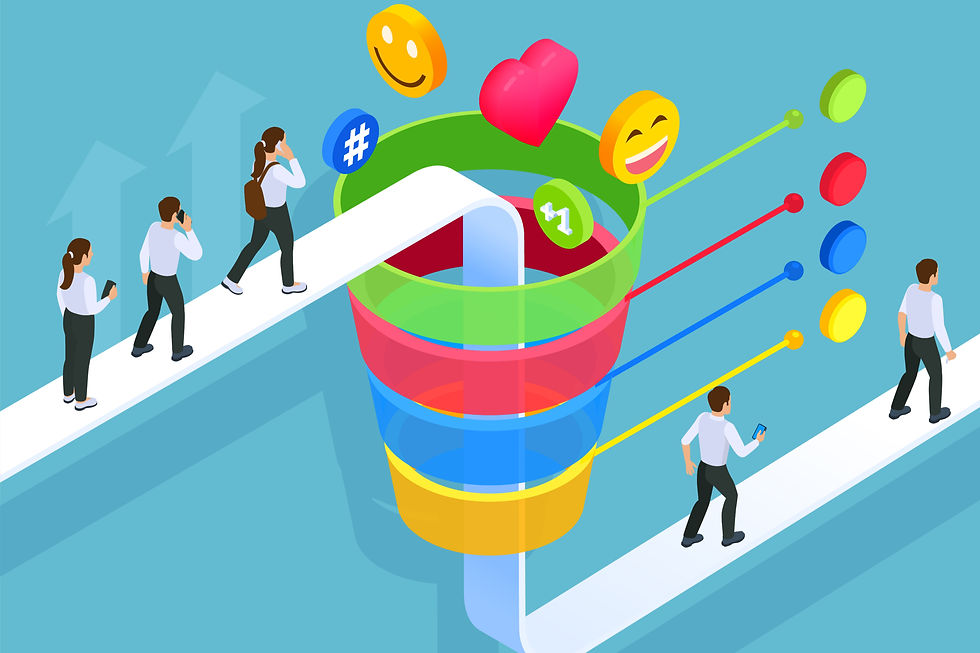Demystifying the Marketing Funnel: The Role of Content at Every Stage
- CONTENT28 Team
- Mar 28
- 3 min read

Most seasoned content strategists for B2B and B2C brands would tell you one thing repeatedly, “A buyer’s journey is never a straight path.” Except when it is an impulse purchase, most decision-makers start in their ‘unaware stage.’
With the millennials plateauing with Gen Z, we have all become chronic review readers. Wondering what does it mean? We often turn to the Internet to learn and understand before deciding on any major purchase. This approach may sometimes become chaotic or even misleading.
However, a strong content strategy from the brand helps customers better understand their needs or solutions, building confidence and trust in the process.
Cracking the Code: Understanding the Marketing Funnel
In all marketing disciplines, understanding your audience is essential. This includes knowing what they think, how they think, the answers they seek, and the typical path they take to find a solution. This knowledge is crucial for crafting a well-documented content strategy that aligns with the various marketing funnel stages. It also ensures relevance at each layer of the buyer’s journey.
A disconnect between a business and its audience often signals a deeper problem—a lack of understanding. In simple terms, if you’re not paying attention to your customers, you’re losing them. The marketing funnel is divided into three key stages:
Top of the Funnel (ToFu) – Awareness
Middle of the Funnel (MoFu) – Consideration
Bottom of the Funnel (BoFu) – Decision
Each stage plays a crucial role in guiding potential customers toward conversion. Demand Metric shows that 90% of businesses use content marketing, and 70% of consumers prefer discovering new brands through articles instead of ads.
Let’s break down the funnel and explore how content shapes the customer journey at every step.
Top of the Funnel (ToFu) – Sparking Interest and Building Awareness
At the top of the funnel, potential customers are just realizing their needs or problems—some may not even know your brand exists. Your content strategy here is simple: attract their attention and educate them.
This is why top-of-funnel content should focus on being informative, easy to understand, and SEO-optimized—ensuring potential customers can find it effortlessly through search engines. Blog posts and articles with a subtle promotional touch work well here. On social media, engaging reels, posts, and infographics help boost brand awareness.
A great example is Airbnb’s travel guides, which provide valuable destination insights while subtly promoting their stays. Short explainer videos on YouTube and podcasts can further build trust and establish authority.
Middle of the Funnel (MoFu) – Consideration: Nurturing Trust and Interest
In the middle of the funnel, potential customers are aware of their problem and actively searching for solutions. At this stage, they compare brands, read reviews, and gather more information. Your content should focus on building credibility. Case studies showing real user success stories can be highly effective here, as they demonstrate the value of your product or service.
A great example is Unacademy, which shares student success stories to inspire trust. Live demos and webinars also position your brand as an expert, adding value during this stage. Depending on your product, white papers and comparison guides can help clarify why your solution is superior to competitors.
Bottom of the Funnel (BoFu) – Decision: Turning Interest into Action
At the bottom of the funnel, potential customers are almost ready to make a purchase—what they need is the final nudge. This is where your content strategy can make all the difference. At this stage, customer testimonials and reviews are powerful tools. People trust real customer feedback over ads, and e-commerce platforms are great examples of this, with reviews prominently influencing buying decisions.
For example, at the bottom of the funnel, Myntra leverages customer reviews and ratings to help shoppers make their final purchase decisions. They also often offer limited-time discounts, flash sales, and exclusive app deals, creating a sense of urgency. Additionally, Myntra’s “Trending Now” section highlights popular products, further nudging hesitant buyers toward conversion. Combining social proof, time-sensitive offers, and trending product visibility helps Myntra turn potential customers into buyers.

Conclusion
Mastering the marketing funnel is key to crafting a content strategy that effectively guides potential customers from awareness to decision-making. Each stage—ToFu, MoFu, and BoFu—requires custom content that speaks directly to the target customer’s needs and mindset.
Whether creating awareness through educational content at the top, building trust with compelling case studies and reviews in the middle, or offering a final nudge with customer testimonials and time-sensitive offers at the bottom, content is the driving force behind conversions.
By understanding and aligning your content with each stage of the funnel, you can build lasting relationships, drive meaningful engagement, and turn prospects into loyal customers.




Comments